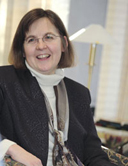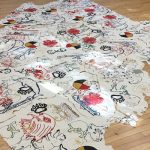With the benefit of having had an early sneak peek at the Per Kirkeby exhibition opening this week at the Bowdoin College Museum of Art, Dean for Academic Affairs Cristle Collins Judd offers context to the Danish artist, his background in geology and their appropriate convergence against a backdrop of the liberal arts. This is the first in a series of columns by Dean Judd about happenings in the academic program at the College.

Dean Cristle Collins Judd
“To count nature a familiar acquaintance and art an intimate friend….” That line from The Offer of the College has a special resonance this spring at Bowdoin as the Bowdoin College Museum of Art opens this week a spectacular exhibition of the work of the Danish painter Per Kirkeby. Bowdoin is the only other U.S. venue for this exhibition, which originated at the Phillips Collection in Washington, D.C., to rave reviews (and a recent nod to the exhibition catalogue in The New York Times highlights the opening here).
Having just enjoyed the privilege of a sneak preview as the installation was going up, I can confirm that the paintings and bronzes of the exhibition will speak boldly to art lovers and museum-goers in a beautiful presentation in our stunning museum. The art and the building — and the ability of one to relate to the other – have arguably never looked better. But viewers of the exhibition here at Bowdoin will have an opportunity that the Phillips Collection simply couldn’t provide: a deep and rich context for the appreciation of these works. By doing what we do best as the home of a college art museum – making connections across and throughout the curriculum – Per Kirkeby’s art will engage the campus in programming that will not only provide revelations on the artwork, but in which art and the way we understand it will speak directly to our contemplation and study of nature and science and vice versa.
Per Kirkeby was originally trained as a geologist and spent time on expeditions to the arctic circle. Both of those circumstances have immediate connections for Bowdoin. We have a long and storied history of arctic exploration and study and were delighted to learn that Kirkeby had spent time in Peary Land! At the end of May, the Peary MacMillan Arctic Museum will present Peary’s and Kirkeby’s photographs of Peary Land side by side in the exhibition Views of Peary Land. And we posses a deep connection to the founding of geology as a discipline.
We often highlight the significance of the bequest by James Bowdoin III of old master drawings and federalist portraits in 1811, which formed the nucleus of what was to become one of the oldest and most prestigious art collections in the country. Less well known, perhaps, is the fact that James Bowdoin III also left the College an impressive collection of mineral specimens, technical writings and scientific instruments. At about the same time, Parker Cleaveland was appointed to the Bowdoin faculty (1805) as the first professor of “mathematics and natural philosophy.” Bowdoin’s distinguished mineral and instrument collection served as an important resource for Cleaveland’s work. Ultimately he gained a reputation as one of the founding fathers of the study of geology in North America for his textbook An Elementary Treatise on Mineralogy and Geology (first published in 1816). In the process, he built for the College an extraordinary collection of geologic specimens, which were joined to those bequeathed by James Bowdoin III. In the latter part of the 19th century these were displayed in the upper floors of Massachusetts Hall in what was known as the “Cleaveland Cabinet.”
So for us, understanding and responding to the art of this Danish geologist and arctic explorer resulted in a companion exhibit, Sense of Scale, Measure of Color: Art, Science and Mathematics of Planet Earth, organized by Mellon Postdoctoral Curatorial Fellow Sarah Montross in conjunction with faculty members Collin Roesler, Emily Peterman and Mary Lou Zeeman. This exhibition displays and engages many of the historic specimens in our collection as well as the contemporary work of these scientists in relation to understanding the shared role color, pattern and scale take on in science and art. Seeing the crystalline structures of the natural world opens our eyes to the abstract patterns of Kirkeby’s paintings. And Kirkeby’s paintings open our interpretation for the kinds of evidence with which scientists interpret our world. A rich array of programming across the semester will include gallery talks by faculty from a number of disciplines, culminating with a dramatic reading of texts by Per Kirkeby, who is also an accomplished poet, in the galleries.
A lot has changed since the days of James Bowdoin III and Parker Cleaveland: the Museum enjoys a beautifully renovated building in which it hosts spectacular exhibitions like these. And Geology as earth system science has been reimagined in a thriving department of Earth and Oceanographic Science. But core values of understanding the value of the arts and the natural world around us remain central to the academic enterprise at Bowdoin.
“To count nature a familiar acquaintance and art an intimate friend….” Come enjoy Per Kirkeby: Paintings and Sculpture and the associated exhibition Sense of Scale, Measure of Color: Art, Science, and the Mathematics of Planet Earth. I hope you’ll find yourself moved, challenged and excited by the dialogue and synergy between these familiar acquaintances and intimate friends.
